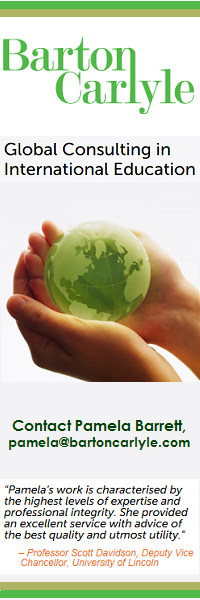International Educators
- About USjournal.com, LLC
- Advertising / Promotional Options
- Advertising Rate Card (pdf)
- Academic Program Listing (pdf)

- Current USjournal.com Advertisers
- Current USjournal.com Services
- Follow USjournal on LinkedIn
- FundsV Named Innovation Finalist
- Growth in Online Language Usage
- Multi-lingual Campaign Advantages
- SkyRadio Audio Segment (wma)
- Strategic Partnership with USDOC

- USjournal.communique
- USjournal History
- USjournal Innovation Lab
| usjournal.communiqué: e-Recruitment Trends and Techniques August 2002
A Wireless Approach to International Student Recruitment: wap.usjournal.com |
Access wap.usjournal.com on your internet-enabled handheld wireless device!
International educators who travel overseas are quite familiar with the phenomenal popularity of wireless internet access, via cell phone, palm-held device or other mobile instruments. Those who have embraced text messaging and web-surfing on-the-run fall into our targeted demographic market: fast-paced, globally-minded executives and tech-savvy students in their late-teens and early 20s.
In Japan, for example, roughly twice as many internet subscribers connect via wireless than dial-up, cable-modem and DSL combined. As of January 2002, wireless internet users in Japan surpassed 50 million people, according to estimates from that country's Ministry of Public Management, Home Affairs, Posts and Telecommunications.
Clearly, the wireless internet frenzy has evolved far beyond its origins in the Scandinavian countries (home of the world's major mobile phone manufacturers). Industry analysts expect the wireless internet market to grow six-fold worldwide between 2001 and 2006. Not surprisingly, the most popular locations for such technology lie in densely-populated metropolitan regions, where mobile phone companies can sell high volumes of low-cost phones and service plans feeding off a limited number of telecommunications towers. Based on that kind of research, the U.S. Journal of Academics decided to invest in a wireless application.
Over the course of the past several years, we've resisted jumping on every techno-bandwagon that rumbles through town. A few years ago, for example, we tinkered with the idea of creating CD-Roms to distribute overseas. Ultimately, we opted against it because the CD medium was too static; it simply did not correspond with our dynamic mission, which is to provide prospective international students with an exclusive guide to U.S. campuses that specifically seek to welcome them.
Wireless technology truly complements usjournal.com's mission, as our programmers integrated the fundamental functions of our HTML format into our WAP format:
- Prospective students quickly and conveniently select their degree preference, academic program preference, financial support, and U.S. geographic preference.
- Results include advertiser programs that match those particular criteria.
- The student selects specific programs that interest him / her. We expect to maintain a similar percentage (35%) of students who inquire about only one U.S. campus -- which provides a very qualified lead for that particular advertiser.
- Students must proceed through the filtering mechanism on our WAP version. That approach differs slightly from our HTML version, where students may identify specific advertising campuses via banner ads or our internal search mechanism.
From the Advertiser's Perspective: The effects of this new wireless technology at usjournal.com will be mostly transparent to advertisers.
- After a prospective student inquires about a particular program, he / she still receives the advertisers' customized automated e-mail responses, which (in most cases) direct them to specific application procedures within their own .edu domains.
- Advertisers continue to receive instant notification of the student's interest.
- Student data continues to be automatically fed into Excel Reports, which are compiled and sent as attachments to the advertiser on a monthly or quarterly basis.
The only real difference with this new wireless technology involves the amount of data collected from the prospective student. (Our HTML version is not affected, and still requires more than 20 different fields.) Due to the fact that fewer and fewer international admissions offices are mailing printed material to prospective students, the students' mailing address is less important, so we eliminated it from our WAP format. We retained the following critical fields:
- Given Name
- Family Name
- Citizenship
- e-Mail Address
- Expected Start Date
- Degree Preference
- Academic Program Preference
- Financial Support
- U.S. Geographic Preference (optional)
If you would like to evaluate our WAP application, please e-mail cheryl@usjournal.com. As usual, we welcome your feedback.
We're dedicated to keeping our finger on the pulse of the industry; the U.S. Journal of Academics has been leading the way in online international student recruitment for years. Our innovative, copyrighted system's sophisticated mechanisms facilitate human interaction (albeit via e-mail in most cases) between prospective non-U.S. students and U.S.-based admissions counselors.
We would be delighted to assist you in enhancing your global promotional efforts. Call us at 570-339-4731, or e-mail cheryl@usjournal.com for more info. Thanks!
You are welcome to re-print this usjournal.communiqué in full, under the condition that you include "Reprinted with permission of Cheryl Darrup-Boychuck, U.S. Journal of Academics, cheryl@usjournal.com."
Please let us know if you have other suggestions for topics in usjournal.communiqué. If you would like to subscribe to this brief e-newsletter, please complete the form. Thanks!

